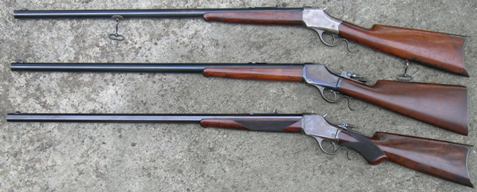April 15, 2005
 Offline
Offlineclarence said
HOW the customer would specify which frame size, with no identification provided by catalogs or ads, is exactly the problem. As I said, a customer could describe in his own words what he wanted, but that’s a clumsy way to go about it.
After reviewing all of the Winchester catalogs from November 1885 through the 1900 catalog, it appears the frame size provided was determined by Winchester when the specific cartridge and barrel size were ordered. Winchester clearly specific what barrel sizes were available for all of the standard cartridges offered.
WACA Historian & Board of Director Member #6571L

November 1, 2013
 Offline
OfflineBert H. said
After reviewing all of the Winchester catalogs from November 1885 through the 1900 catalog, it appears the frame size provided was determined by Winchester when the specific cartridge and barrel size were ordered. Winchester clearly specific what barrel sizes were available for all of the standard cartridges offered.
No doubt that’s the way it was usually done–but that means it was the factory & not the customer who was doing the deciding. Which still leaves unexplained the mystery of the .38-56 & .40-65 LWs.
April 15, 2005
 Offline
Offlineclarence said
No doubt that’s the way it was usually done–but that means it was the factory & not the customer who was doing the deciding. Which still leaves unexplained the mystery of the .38-56 & .40-65 LWs.
Those two rifles were undoubtedly uniquely special ordered by the customer. I suspect that the order was worded something like, “I want a Single Shot rifle in 38-56 WCF that is as light as can possibly be made”.
Bert
WACA Historian & Board of Director Member #6571L

September 22, 2011
 Offline
OfflineBert H. said
I suspect that the order was worded something like, “I want a Single Shot rifle in 38-56 WCF that is as light as can possibly be made”.
I bet the odds are that it happened exactly this way. GREAT hypothesis, Bert! No mention of low wall vs high wall but instead, the desire for a lighter rifle.
November 19, 2006
 Online
Onlinemrcvs said
Bert H. said
I suspect that the order was worded something like, “I want a Single Shot rifle in 38-56 WCF that is as light as can possibly be made”.I bet the odds are that it happened exactly this way. GREAT hypothesis, Bert! No mention of low wall vs high wall but instead, the desire for a lighter rifle.
The .38-56 in question, had as I recall, a factory letter. I have the shadow of a memory that there was some mention in the letter of the customer’s desire for light weight?
April 15, 2005
 Offline
Offlinesteve004 said
The .38-56 in question, had as I recall, a factory letter. I have the shadow of a memory that there was some mention in the letter of the customer’s desire for light weight?
The factory letter does not make any mention of “light weight”.
WACA Historian & Board of Director Member #6571L

November 7, 2015
 Offline
OfflineInteresting thread. In today’s mass-produced world I’m fascinated by a big company that produced items made to order and quite often one of a kind. I’m starting to understand why Bert is still fascinated by the 1885 after all these years. It’s a shame so many records we’d love to see were used to heat the factory (and workers) we revere today.
To address the OP I suspect the options selected helped determine the frame type. In my business I love a customer that knows exactly what he wants and I will make every effort to accommodate him. I suspect the folks who processed custom orders felt the same way.
Mike


 Log In
Log In





